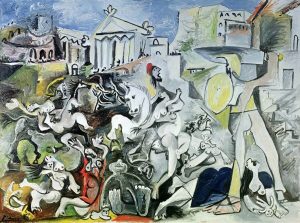The Origins of Rome

In this module, you will read Livy’s story of the founding of Rome, which contains two defining moments of rape: Rhea Silva and the Sabine Women. The first book of Vergil’s Aeneid is included as well; Vergil tells an abbreviated “history” of early Rome (delivered as the fated future) and introduces Dido, another pivotal woman parlayed into Rome’s inexorable rise.
Time permitting, do some research on the afterlife of the rape of the Sabine women in art. How many representations of this scene can you find?
Finally, please read Aimee Hinds’ Eidolon piece: “Rape or Romance?”
If you are too busy/stressed/blue-lit to get through all of the readings for this week and something has to give, please pay close attention to the Livy and Vergil and opt out of the last, optional, chapter:
To think through how to read material (Livy more obviously, and Vergil more subtly) that centers rape, you may OPTIONALLY read Amy Richlin’s Reading Ovid’s Rapes. Richlin quotes Ovid’s version of the rape of the Sabine Women and references his telling of the rape of Lucretia, which you will for read next week.
Although we won’t be diving into the Metamorphoses, which Richlin discusses at some length, the questions she asks — and suggestions she makes — will help us organize our work in this and our next module. If you are interested to take up Ovid’s Met, it is a rich, dense text with lots of content worth engaging in from a feminist, intersectional perspective and you could do so for your final project in this seminar (or join me sometime in Intermediate Latin, where we translate some of the passages Richlin references and have some rich conversations about whether they are worth the effort.)
Please prepare this module (continuing to annotate with hypothes.is) for 9/15.
